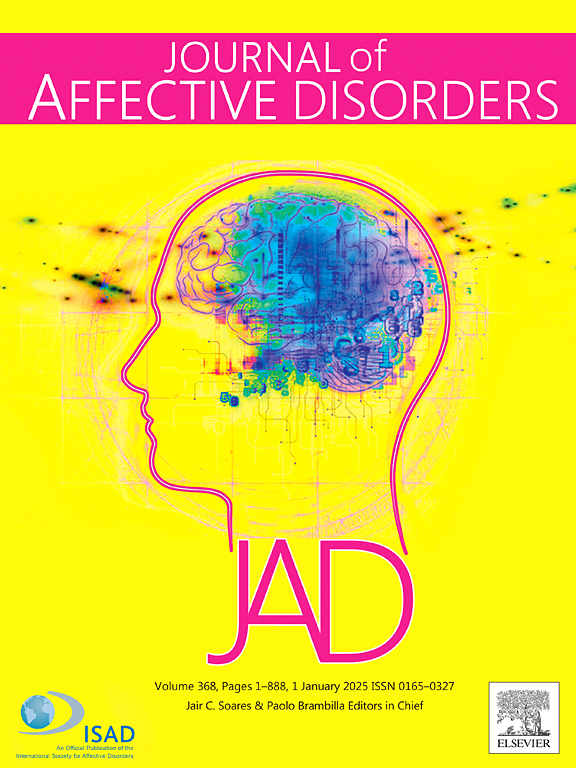基于无标记数据独立获取蛋白质组学技术的不同类型抑郁症血浆蛋白质组学研究。
IF 4.9
2区 医学
Q1 CLINICAL NEUROLOGY
引用次数: 0
摘要
背景:由于抑郁障碍的高发病率和高误诊率,迫切需要准确诊断抑郁障碍的生物标志物来降低误诊率和提高治愈率:为了获得原始数据,研究人员收集了各种抑郁障碍患者的血浆样本,包括药物治疗前的双相抑郁症(BP)、重度抑郁障碍(MDD)和持续性抑郁障碍(PDD)患者,以及未被诊断为精神病的参与者(NP)。然后使用纳米液相色谱-质谱/质谱对这些样本进行分析。根据筛选标准,确定了与不同类型抑郁障碍相对应的差异表达蛋白(DEPs),并通过生物信息学分析确定了验证蛋白并进行了验证:结果:在 BP 和 NP 之间发现了 99 个 DEPs,在 MDD 和 NP 之间发现了 29 个 DEPs,在 PDD 和 NP 之间发现了 14 个 DEPs。抑郁症患者血浆中的 PRDX2 水平明显升高。BP患者的血浆CRP水平明显升高,MDD患者的血浆SNCA水平明显升高。CRP在区分BP与NP、MDD和PDD方面显示出最佳的鉴别诊断能力,而SNCA在区分MDD与NP、BP和PDD方面显示出最佳的鉴别诊断能力:结论:抑郁症的发病机制主要涉及与炎症和脂质代谢相关的生物过程和信号通路。结论:抑郁症的发病机制主要涉及与炎症和脂质代谢相关的生物学过程和信号通路,蛋白质组学所发现的关键生物标志物及其所涉及的信号通路对于揭示抑郁症的生物学基础、指导临床诊断和治疗具有重要意义。本文章由计算机程序翻译,如有差异,请以英文原文为准。
A study on the plasma proteomics of different types of depressive disorders based on label-free data-independent acquisition proteomic technology
Background
Due to the high incidence and high misdiagnosis rate of depressive disorder, biomarkers for the accurate diagnosis of depressive disorder are urgently needed to reduce the misdiagnosis rate and improve the cure rate.
Methods
To obtain original data, plasma samples were collected from patients suffering from various depressive disorders, including bipolar depression (BP), major depressive disorder (MDD), and persistent depressive disorder (PDD) prior to medication treatment, as well as from participants without psychiatric diagnoses (NP). Then these samples were analyzed using nano-LC–MS/MS. According to the screening criteria, differentially expressed proteins(DEPs) corresponding to different types of depressive disorders were identified, and validation proteins were identified via bioinformatics analysis and verified.
Results
Ninety-nine DEPs were identified between BP and NP, 29 DEPs were identified between MDD and NP, and 14 DEPs were identified between PDD and NP. The plasma levels of PRDX2 in patients with depressive disorder were significantly increased. The plasma CRP level in BP patients was specifically increased, and the plasma SNCA level in MDD patients was specifically increased. CRP showed the best differential diagnostic ability in differentiating BP from NP, MDD and PDD, and SNCA showed the best differential diagnostic ability in differentiating MDD from NP, BP and PDD.
Conclusions
The mechanism of depressive disorder mainly involves biological processes and signaling pathways related to inflammation and lipid metabolism. The key biomarkers identified by proteomics and the signaling pathways involved are highly important for revealing the biological basis of depressive disorder and guiding its clinical diagnosis and treatment.
求助全文
通过发布文献求助,成功后即可免费获取论文全文。
去求助
来源期刊

Journal of affective disorders
医学-精神病学
CiteScore
10.90
自引率
6.10%
发文量
1319
审稿时长
9.3 weeks
期刊介绍:
The Journal of Affective Disorders publishes papers concerned with affective disorders in the widest sense: depression, mania, mood spectrum, emotions and personality, anxiety and stress. It is interdisciplinary and aims to bring together different approaches for a diverse readership. Top quality papers will be accepted dealing with any aspect of affective disorders, including neuroimaging, cognitive neurosciences, genetics, molecular biology, experimental and clinical neurosciences, pharmacology, neuroimmunoendocrinology, intervention and treatment trials.
 求助内容:
求助内容: 应助结果提醒方式:
应助结果提醒方式:


